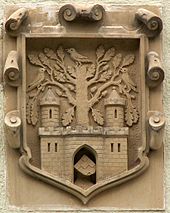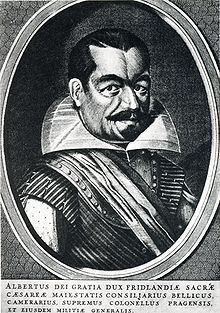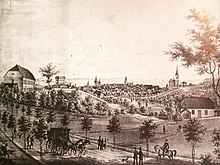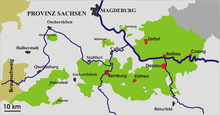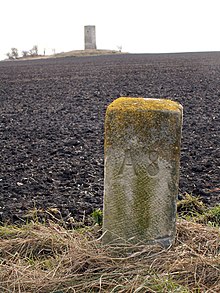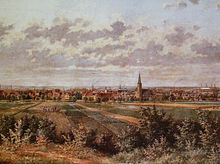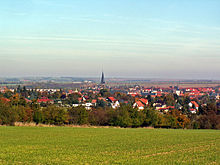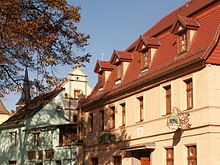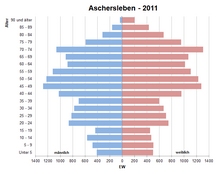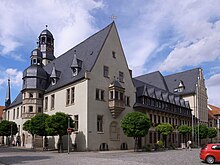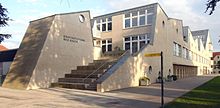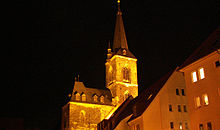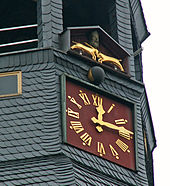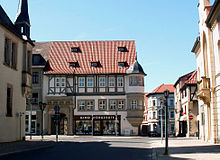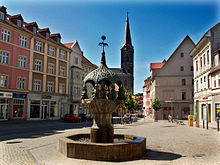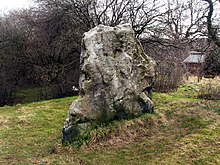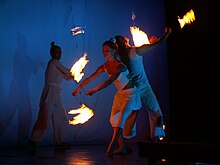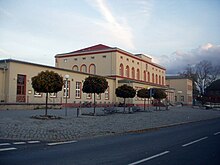Aschersleben
| coat of arms | Germany map | |
|---|---|---|
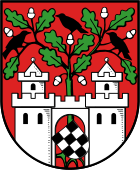
|
Coordinates: 51 ° 45 ' N , 11 ° 27' E |
|
| Basic data | ||
| State : | Saxony-Anhalt | |
| County : | Salzlandkreis | |
| Height : | 114 m above sea level NHN | |
| Area : | 156.23 km 2 | |
| Residents: | 27,012 (Dec. 31, 2019) | |
| Population density : | 173 inhabitants per km 2 | |
| Postal code : | 06449 | |
| Area code : | 03473 | |
| License plate : | SLK, ASL, BBG, SBK, SFT | |
| Community key : | 15 0 89 015 | |
| LOCODE : | DE ASN | |
| NUTS : | DEE0C | |
| City structure: | 11 districts + city center | |
City administration address : |
Markt 1 06449 Aschersleben |
|
| Website : | ||
| Lord Mayor : | Andreas Michelmann (WIDAB) | |
| Location of the city of Aschersleben in the Salzland district | ||
Aschersleben ( ) is a town on the northeastern edge of the Harz Mountains in the valley of the Eine in Saxony-Anhalt . It is the third largest city in the Salzlandkreis and the oldest documented city in Saxony-Anhalt. Due to its geographical location, Aschersleben is also known as the “gateway to the Harz”.
Aschersleben was the seat of the Ascanians , who derived their name from Ascharia , the Latinized name of their castle property . In the 12th century it became the center of the later Principality of Anhalt under the Ascanian Albrecht the Bear . In the late Middle Ages the city was a member of the Hanseatic League . As one of the few cities in Germany, it has a very well-preserved city fortifications and a largely intact inner city from the Middle Ages.

The city is under renovation and was part of the International Building Exhibition Urban Redevelopment Saxony-Anhalt 2010 . In 2010 she hosted the State Horticultural Show Saxony-Anhalt. Aschersleben has the rank of a middle center . Due to its favorable climatic location in the rain shadow of the Harz Mountains, the city became the center of marjoram cultivation in Germany.
geography
Aschersleben is located between the Harz Mountains and the Magdeburg Börde , about 50 kilometers southwest of Magdeburg and about 50 kilometers northwest of Halle (Saale) . The city lies in a narrow river valley of the Eine , which is bounded in the south and southwest by the Wolfsberg and flows southeast of the city into the Wipper . A two-kilometer-long shell limestone ridge , known as the Old Castle , rises an average of 40 meters above the city and reaches its highest point at Westdorfer Warte ( 160 m above sea level ).
The area around the city is characterized by hilly farmland. To the northwest, Lake Concordia and Lake Königsau, are two large flooded open-cast mining areas. West of the city, but there is a remnant of the once up Gatersleben reaching Aschersleber lake .
Until 1945, Aschersleben was in the province of Saxony and was surrounded by the Duchy of Anhalt to the west, east and south-east . The state border, the old boundary stones of which are still visible, was sometimes only two kilometers from the city limits. To the south of Aschersleben runs the language border between the German dialects Ostfälisch and Thuringian , the so-called Benrath line .
City structure and districts
The medieval town in the year 1000 developed first of two independent districts, the Episcopal city and the shire of askanischen count. The episcopal city was owned by the Halberstadt bishop and comprised the area between Breiter Straße in the north and Hopfenmarkt in the south. It included the first Romanesque St. Stephen's Church and a relatively large market square around this church. It was therefore also called Stephansstadt . In the 12th century Albrecht the Bear managed to acquire 3,000 feet from the Fulda Monastery , which also included Fulda’s Aschersleber property. It was located southwest of the episcopal city. Later extensions were added that extended to today's Schuhstieg and thus bordered the episcopal city. The Ascanian possessions also included the so-called Neustadt and the districts Über dem Wasser and Über den Steinen , as well as the area of the Kiethof in the later water suburb on Apothekergraben.
While the suburbium was predominantly village-like, the market around the Romanesque church in the civitas already had an urban character due to the settlement of craftsmen and merchants. This administrative peculiarity of Aschersleben with two city lords lasted until 1262 and led to decades of friction between the Halberstadt bishops and the Ascanian counts. It was not until this year that Heinrich II von Aschersleben was awarded the civitas after a settlement, and Aschersleben was now under uniform administration. In 1263 the Aschersleben episcopal city was designated as an episcopal fief under Ascanian rule.
After the Ascanians died out in Aschersleben, the next expansion took place in the eastern area and encompassed today's streets Ritterstraße and Badstuben . This extension was followed by the northern development of the Tie suburb until about the construction of the city fortifications in 1322 . In this area, today's market has also been laid out as a large square. The last extensions to the old town are the areas of the front and rear width as well as the wood market .
Localities
In addition to the core city, there are eleven other villages in the city of Aschersleben:
| Locality | Residents |
The towns of Aschersleben (clickable map) |
|---|---|---|
| Drohndorf | 514 | |
| Freckleben | 714 | |
| Gross Schierstedt | 602 | |
| Klein Schierstedt | 395 | |
| Mehringen | 1098 | |
| New Königsaue | 343 | |
| Schackenthal | 327 | |
| Schackstedt | 441 | |
| Westdorf | 905 | |
| Wilsleben | 529 | |
| Winningen | 842 |
Neighboring communities
Aschersleben borders on ten cities and towns in Saxony-Anhalt. Starting in the north, these are clockwise: the town of Hecklingen , the town of Giersleben and the town of Güsten , in the east the town of Plötzkau and the town of Alsleben (Saale) , in the south-east the town of Könnern , in the south the town of Arnstein , in the west the town of Falkenstein / Harz and the city of Zealand in the northwest .
geology
The Aschersleben saddle is the Hercynian saddle-shaped bulge of the Zechstein and the Triassic , which extends to the northwest in the Subherzynen valley from Sandersleben under Mehringen and Aschersleben.
This saddle was created together with the Alte Burg ridge through mountain-forming processes such as folding and elevation in the late Cretaceous around 80 million years ago. The so-called Aschersleber saddle and the Staßfurt-Egelner saddle are edge structures of the Aschersleben-Staßfurt sloping block. The lateral expansions of the main saddle in the direction of the Erzgebirge are particularly noticeable, so that the area of Aschersleben is referred to as the broad saddle .
The northeast flank is covered by Middle Buntsandstein , and on its southwest flank are Middle and Upper Buntsandstein and all of the shell limestone , the southern elevation of which is the shell limestone ridge of the old castle. The middle red sandstone stripes in the area of the cranial planes under tertiary and quaternary layers and merges to the west into the Winningen red sandstone area. The tectonically activated Zechstein and Keupersalinar formed salt cushions from potash over tectonic weak zones . The cutting of the Zechstein formations of the ascending saddle through erosion was made for the Aschersleber salt saddle in the Middle Eocene.
In the sinking marginal depressions of the rising salt dome of Aschersleben, an extensive bog formed in the Eocene (49–37 million years ago). The larger lignite deposits at Frose , Nachterstedt and a smaller seam north of Aschersleben were thus able to arise.
climate
The city lies in the moderate climatic zone and in the rain shadow of the Harz Mountains. In this area there is a long-term average of only 492 millimeters of precipitation, in the main vegetation period from April to October only 350 millimeters of precipitation. The upper resin, on the other hand, receives two to three times the amount. Most of the precipitation falls in June with an average of 61 millimeters, the lowest in February with an average of 24 millimeters. The mean July temperature is around 18 ° C, the January mean around 0 ° C. The relatively high summer temperatures result in strong evaporation and thus increased dehydration. One speaks of the Central German or Herzynischen dry area .
The growing season with an average temperature above 5 ° C is relatively long with 230 days. The annual total of foggy days is approximately 52 with annual fluctuations between 20 and 80 days. The average amount of sunshine a year is around 1,535 hours of sunshine, the relative humidity around 79 percent. The monthly means fluctuate between 72 and 84 percent.
|
Monthly average precipitation for Aschersleben
Source: German Weather Service
|
|||||||||||||||||||||||||||||||||||||||||||||||||||||||||||||||||||||||||||
Due to the favorable climatic conditions and suitable biotopes, warmth-loving, southern European fauna elements such as the wall lizard (Podarcis muralis muralis) and the European praying mantis (Mantis religiosa) occur in the urban area.
history
Early history
The climatically favorable location in the rain shadow of the Harz already attracted people to the area where Aschersleben is today. The Einetal, which emerges from the Vorharz here, and the very fertile soil played an important role in the early settlement of the area.
The oldest finds from a hunting camp come from the Bruchsberg near Königsaue, about five kilometers from the city of Aschersleben, and date from more than 55,800 years ago. The Aschersleber Lake , which until it was drained at the time of Frederick the Great, largely existed as a twelve-kilometer-long flat lake , was repeatedly visited by hunters and gatherers on its shores . Numerous finds of flat and humped graves as well as grave goods from the Neolithic confirm this.
At the time of the Great Migration , the warning settled in the area. Locations with the ending Leben indicate this. The name Aschersleben is made up of the personal name Asceger ( Escherner Wurfspeer ger = spear) and -leben ( lev = inheritance, legacy).
Up-and-coming city in the Middle Ages
In the Codex Eberhardi compiled in the middle of the 12th century , a place in Thuringia called Ascegereslebe was allegedly first mentioned in 748. The template is said to be based on a deed of donation from the Passau choir bishop Madalwin (died after 903), who transferred his property in Aschersleben "including the serfs" to St. Boniface ( Fulda Monastery ). The mention of Aschersleben did not follow a temporal, but a geographical order and was therefore at the geographically determined location where the donation was. Due to the lack of a date, the assumption arose that that first mention could also fall in the 9th century. The mention of a place "Aschershausen" in the course of the 748 devastated villages in the dispute between Pippin and his half-brother Grifo spoke in favor of a mention in the 8th century . This document, which reported on the devastation, was dated by the Marburg historian Edmund Ernst Stengel in 1960 to the third quarter of the 9th century, which means that Aschersleben was first mentioned in the years between 850 and 875.
In the 11th century, the city passed into the possession of the Ascan family . Their name came from Ascania or Ascharia , the Latinized form of Aschersleben Castle, whereby the ending -leben was omitted. Albrecht the Bear was at the head of the House of Askanien-Anhalt. He went down in German history as the Margrave of the Nordmark and even more as the founder of the Mark Brandenburg and was the first to use both names. The branch line of the Anhaltines was established in 1212. Under Albrecht I, Aschersleben became the center of the surrounding administrative and court district. Sources of the time tell of numerous dishes in and around the city. The gravescap to aschersleve was mentioned in the medieval law book Sachsenspiegel .
The fact that Aschersleben's own coins were put into circulation for the first time shows that Aschersleben was of particular importance to Albrecht the Bear. Around 1860 numerous bracteates were found near Freckleben that show the portrait of Albrecht the Bear. These bracteates and denarii were the first Anhalt coins. In 1120 the construction of the Askanierburg began. The location of the castle is still controversial today, but the location in Aschersleben is probably where it is today, on Burgplatz . It is worth mentioning the slaughter of Udo von Freckleben in 1130 by the followers of Albrecht the Bear during a feud . When Albrecht the Bear probably died in Stendal on November 18, 1170 , the Ascanians were among the most important families of princes in the Holy Roman Empire . He left behind a large area of rulership that included the county of Aschersleben, Brandenburg, Saxony-Wittenberg, Saxony-Lauenburg and parts of Thuringia.
The area was now taken over by five of his seven sons. There was an inheritance division within the Ascanian house . His youngest son Bernhard III. (1140-1212) received the Ascanian possessions east of the Saale and, after the early death of his brother Adalbert in 1171, also the Ballenstedt area. Bernhard founded the Ascanian county of Aschersleben within the Principality of Anhalt in the 12th century , after which the city became the county seat, administrative and court location.
In the period that followed, the Ascanians repeatedly clashed with their great rivals, the Guelphs , especially in the dispute over the Duchy of Saxony . The Guelphs under Heinrich the Lion not only destroyed Anhalt Castle in the Selke Valley in 1140 , but also devastated Aschersleben in 1142 and 1175. After the death of his father, Bernhard III., In 1212, the land was divided between the two sons of the deceased, as is customary with the Ascanians: Heinrich I (1170–1252) took over the government in Anhalt, and Albrecht took over the Saxon Area. In 1218 Heinrich was raised to the rank of prince.
In 1250 the Marienkloster, located in front of the village, was founded. In 1252, after the death of Prince Heinrich I of Anhalt, Anhalt was divided into three principalities: Anhalt-Aschersleben , Anhalt-Bernburg and Anhalt-Köthen . The seat of the Principality of Anhalt-Aschersleben was Aschersleben with Heinrich II at the head. The importance of the place grew: a farming village became a town. Heinrich II granted Aschersleben city rights in 1266 . When Heinrich died in 1266, his son Otto I (Anhalt) inherited him and after his death in 1304 Otto II became the regent of Aschersleben. Otto II, Count of Asharia and Prince of Anhalt, died in 1315. He left two daughters, Elisabeth and Katharina, but no male heirs.
From then on, a decade-long struggle for the Aschersleber legacy broke out. In December 1316, Bishop Albrecht I von Halberstadt enfeoffed his brother, Count Bernhard II , with the house and town of Aschersleben. The Bernburger thus recognized the feudal sovereignty of the bishop. Two years later, King Ludwig IV enfeoffed Bernhard II with all the property that Otto II had had as a fief from the empire .
The wife of the late Otto II, Countess Elisabeth, received Aschersleben as a widow's residence and had to obtain the approval of both daughters and Bernhard II for donations. In 1322 the dispute over Aschersleben between Bernhard III. von Anhalt-Bernburg and Halberstadt Bishop Albrecht II of Braunschweig-Lüneburg to a bitter legal battle.
Although Emperor Ludwig IV the Bavarian intervened several times in favor of Bernhard, Aschersleben stayed with the Halberstadt Monastery . The citizens of Aschersleber took the side of Halberstadt during this dispute under the motto Under the crook is good living .
In 1322, work on building the city fortifications began after Elisabeth, the widow of the last Count of Aschersleber, had given permission. The Latin school of Aschersleben (today Stephaneum ) was first mentioned in 1325 . In 1326 the city merged with Halberstadt and Quedlinburg to form the Halberstadt Tri- City League , which was to last uninterrupted until 1477. In 1380 the construction of the St. John's Tower began. An interdict should be imposed on Aschersleben because of lack of money . Pope Benedict XIII forbade this in 1401.
The construction of the Stephanikirche began in 1406 and lasted until 1507. The plague first appeared in Aschersleben in 1415 . In 1426 Aschersleben joined the Hanseatic League . 70 Rhenish gold guilders were paid for acceptance into the city alliance. This membership lasted until 1518. In 1428 the town received the mayor's office and in 1443 the castle and bailiwick. This made it a free imperial city with a chartered territory and its own administration that was allowed to raise taxes and duties. Large parts of the city fortifications were completed between 1440 and 1470. For this purpose, building material from the old city castle was also reused. After completion, the city wall had a length of 2.3 km, a height of eight meters and a thickness of 0.8 to one meter. Wealthy citizens had even financed some city towers privately and had to occupy them in case of danger, even at the risk of their own lives. The roundabout was built from 1507 to 1583 .

Until the Reformation , the monastery of the barefoot mendicant monks of the Franciscan order was located within the walls of the city , of which the very well-preserved market church is still today . In addition, the Cistercian nunnery of St. Marien was just outside the city walls in the Liebenwahnschen suburb. Most of the city's residents were loyal to the church, so heretics were burned at the stake here in 1454. But also in Aschersleben there were protests against the practices of the church in collecting indulgences. After Martin Luther had posted his 95 theses in Wittenberg to the castle church, it was not long before Luther's teaching found its way into the Halberstadt monastery, to which Aschersleben belonged. The starting point of the Reformation in Aschersleben was the Latin school founded in 1325 at the Stephanikirche .
No document proves that Thomas Müntzer is said to have been an assistant teacher or assistant chaplain (Latin: collaborator ) at this Latin school . Only his testimony on May 16, 1525, extorted through torture, is an indication of his stay in the city: At Aschersleben and Halla do he also did a verbuntus in the youth, when he was a collaborator. Be inside / Peter Blinde zu Aschersleben .... There is evidence of his work as provost at the collegiate church in Frose near Aschersleben. In 1524, the principal of the Latin School, Petrus Lenz, began teaching the Gospel in the spirit of Luther without permission. The majority of the population of Aschersleben turned to the new faith and stayed away from the services in the Catholic St. Stephen's Church.
When the German Peasants' War began in 1525 , farmers took action in some towns and villages in the area, with the town of Aschersleben taking advantage of the opportunity. The actions were directed primarily against the two monasteries based in Aschersleben and their property in different villages. Shortly before the Aschersleben movement took hold in early May 1525, the Franciscans cleared the monastery on the market and moved to Zerbst . The nuns of the Marienkloster initially stayed in their monastery, despite warnings from the city. But after more and more monasteries in the area were looted, the nuns moved into the abandoned Franciscan monastery. In order to protect the nuns, the city council demanded the transfer of all monastery property and patronage for the Stephanikirche. The abbess delivered all possessions, including the monastery archives with all privileges and property files. Shortly afterwards, a bunch of rebellious farmers, together with parts of the poor rural population, plundered the monastery and ravaged it. The city did not prevent the complete destruction of the monastery, as they came closer to the goal of pushing the Catholic Church completely out of the city and gaining more independence from the bishop in Halberstadt. On September 30, 1525, the latter imposed a fine of 6,000 guilders on the city , as well as a further payment of 600 guilders to the nuns. On October 18 of the year, the preacher Petrus Lenz, already mentioned, was called to the office of the first pastor of the church. This was a first success for the Reformation in Aschersleben.
After the peasant uprising was put down and the leaders were executed, it was not until 1541 that the Reformation in the Halberstadt bishopric had finally prevailed. At the turn of the year 1541/42, the two Catholic chaplains of St. Stephen's Church in Aschersleben were occupied by two Protestant pastors.
As everywhere in Europe, the plague was rampant in Aschersleben during this time. In 1528 and 1566 there were new plague epidemics. In 1566 around 1400 people died. The disease raged again in 1625, this time with almost 2,800 deaths.
From the Thirty Years War to the 19th century
After the Thirty Years' War was triggered in May 1618 with the second lintel in Prague , the first troops under Count Otto von der Lippe quartered in the city on August 7th of the same year . Up until 1623 there were several clashes with various arson troops inside and in front of the walls of the city.
From December 30, 1625 to January 4, 1626 General Wallenstein stayed in Aschersleben for the first time. For some time he set up his headquarters in Krukmann's house on the market. As early as January 1626, Wallenstein's troops had taken up strong positions on the Middle Elbe. Two regiments under Aldringen and Collalto had moved into Anhalt and occupied Dessau and the Elbe bridge near Roßlau , which were provided with strong fortifications. Wallenstein himself remained at his headquarters in Aschersleben and directed the advertisements that had been approved by the Kaiser in order to double the size of the army to 60,000 men. Before and after the battle at the Dessau Bridge , Wallenstein moved into his quarters in Aschersleben. Further stays followed until 1630.
In the summer of 1630 the troops of Generals Heinrich von Holk and Bruni and in October the Austrian General Montecuculi and their troops were in the city. Imperial troops first arrived at the beginning of 1631. Shortly after conquering and devastating Magdeburg ( Magdeburg Wedding ), Tilly first came to Aschersleben on May 26, 1631 . Together with Pappenheim , he initially moved on to Staßfurt . After the defeat suffered by the Swedish king Gustav II Adolf in the battle of Breitenfeld , the defeated Tilly and Pappenheim came back to Aschersleben and took quarters here for some time.
In 1632 the Halberstadt Monastery and thus Aschersleben came under Swedish rule. The Diocese of Halberstadt with Aschersleben came to Saxony in May 1635 as a result of the Peace of Prague . The city was sacked several times by Swedish and Imperial troops in the following years.
In 1636 the St. Margaret's Church was plundered and devastated by the Swedes. In 1641 the Swedish commander Hermann left the city and the imperial family came again. In 1642 Archduke Leopold Wilhelm of Austria stayed in the city for some time. Under Count Königsmarck , Swedish vanguard troops stormed the gates in November 1642 and once again regained dominance over the city.
In 1643 there was heavy fighting between the Swedish and imperial troops in the area around Aschersleben. In June Aschersleben was under such great imperial threat that the Swedes decided to demolish the suburb, which consisted of over 400 houses. In 1644 the city was permanently defended by the Swedes. The fortifications and the irrigation of the city ditches were carried out. The Elisabeth and St. Johannis hospitals were torn down. In 1646 there were again numerous raids by looting soldiers through the city.
With the Peace of Westphalia of 1648, Aschersleben fell to Brandenburg as part of the Halberstadt Monastery . Despite numerous attempts by the Anhalt princes to assert claims on Aschersleben, one of the first counties of Anhalt was lost to the House of Anhalt.
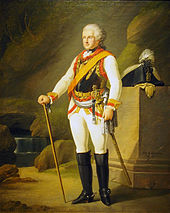
In 1698 Tsar Peter the Great visited the city on his return journey from Holland. The city had to provide 28 four-horse wagons for onward transport, and a further 24 from the surrounding villages. On May 29, 1698, the tsar visited the city again, this time with his own 50 horses as a leader. In 1717 he arrived in Aschersleben for the third and last time when he was passing through from Bernburg to Halberstadt.
In 1722 Aschersleben became a garrison town . The Prussian Cuirassier Regiment No. 6 , which at that time was called the Prince Gustav Cavalry Regiment after its owner General Gustav von Anhalt-Dessau , moved here on May 1, 1722.
During the Seven Years' War , French troops appeared at the gates of the city in 1757 , but were not involved in acts of war here. In October 1760, the city was firmly in French hands for a few days and could only protect itself from pillage and looting by paying 23,000 thalers, handing over dozens of horses and temporarily billeting and feeding the French.
In January 1778 the Masonic lodge Zu den Drei Kleebl Blätter was founded in the city , the temple of which can still be seen in the city museum.
The local 6th Prussian Cuirassier Regiment under Friedrich Wilhelm II moved out three times , for example in 1792 during the campaign in Champagne . The head of the regiment had been Duke Carl August von Weimar in the rank of lieutenant general since 1794 . Even Johann Wolfgang von Goethe was in this period several times with his princely friend in Aschersleben so in the years 1789, 1792 and 1798. Both lived in the building of the regiment commander on Tie 29, corner of High Street, where today a memorial plate on it. The romantic poet Friedrich de la Motte Fouqué was a cadet and later a lieutenant in the cuirassier regiment from 1794 to 1802 and lived in the Lederer-Bräustübl building during his stays. During a ride through the Einetal he is said to have “received” the pictures for his fairy tale Undine , which became widely known through ETA Hoffmann and Albert Lortzing's opera (1845). In his autobiographical life story , Fouqué describes the city and his thoughts about the city at that time in detail.
“The cheerful impression that Aschersleben had made on the young soldier when he set off for the field last year was most gracefully confirmed on his return. In the not unsightly city there was a spiritually scientific and happy life, and we who returned from the fields brought receptiveness and a fresh zest for life "
19th century to 1945
On August 26, 1803, the city was visited by the then King of Sweden , Gustav IV Adolf , with his wife and their entourage.
After the collapse of Prussia in the Battle of Jena in the course of the Napoleonic Wars , many Prussian and Saxon refugees, some of whom were wounded, arrived in the city on October 15, 1806 and moved on to Magdeburg, where they had to gather. On October 20, the more than 20,000-strong French army corps of Marshal Bernadotte moved into the city from Mehringen and moved into camp at Seegraben . These troops took tribute from the city and received more than 4,360 thalers of gold. Immediately afterwards, the officers banned the looting of the urban area, but dozens of French looted the suburbs, including the mills in front of the city, to the ground. On November 22nd, the French corps withdrew towards Bernburg.
As a result of the Peace of Tilsit , Aschersleben fell to the French satellite state Kingdom of Westphalia on July 9, 1807 and was now part of the Halberstadt district in the Département de la Saale . A mayor came to the head of the city . The civil code , French coinage law and court rules now also applied to Aschersleben. Furthermore, the guilds and guilds were abolished. In March 1808 the 1st Westphalian Cuirassier Regiment was established in Aschersleben . However, this soon left the city, and hussars moved here, who stayed until March 1809. From February 1809 to April of that year, a French chasseur regiment camped in the city.
At the beginning of May 1809, a couple of hussars from the Prussian Major von Schill's group appeared for two days . In the course of the summer Aschersleben saw various Dutch regiments, Westphalian hunters, infantry and cavalry detachments and 400 men from Polish troops. From May 1, 1809 and later from February 1810, the 1st Westphalian Cuirassier Regiment again took garrison in Aschersleben. In January 1810 and from April 1811 the 2nd Westphalian Hussar Regiment was also in the city. When Napoleon's troops set out for the Russian campaign in 1812 , Aschersleben saw further troops from the Westphalian and French armies march through. Around 900 citizens of Aschersleben also had to take part in the campaign, and of these only 40 came back alive.
In March 1813 a French army rallied around Quedlinburg under the viceroy of Italy , Eugène de Beauharnais , Napoleon's stepson. From April 12th to 15th, he and his general staff were quartered in Aschersleben. The King of Westphalia, Jérôme Bonaparte , brother of Napoléon, spent an hour in Aschersleben on June 21, 1813, and parts of the tower collapsed shortly after passing through the Hohe Tor . After the Battle of Leipzig and the final withdrawal of the French, Aschersleben became Prussian again on November 4, 1813. On November 19, the Prussian King Friedrich Wilhelm III. permission to form a voluntary hussar regiment with garrison in Aschersleben, which later became the 10th hussar regiment .
After the Congress of Vienna in 1815, Aschersleben was assigned to the newly created Prussian province of Saxony . The city was still in the Prussian corridor between the two Anhalt parts of the country, so to 1834, the year of the accession of Prussia and Anhalt for the German Customs Union , the smuggling in and flourished about Aschersleben around.
In 1850 cholera raged for the first time in Aschersleben, as a result of which 164 people died.
In 1865 the city was connected to the railway network (railway line from Dessau to Halberstadt ), which led to a rapid industrial boom. Industries such as sugar beet processing , potash and salt mining, paper industry and mechanical engineering settled in the city, especially after the establishment of the German Empire in 1871 .
On July 25, 1870, the local hussar regiment moved out to take part in the Franco-German War . In the autumn of 1870 the first 500 French prisoners of war came to Aschersleben. Their number increased to 1500 in the course of the war. On April 18, 1871, the first part of the French left the city, the last French officers were allowed to leave the city on June 11. On June 30, 1871, the local hussar regiment arrived again.
In 1884 the time as a garrison location ended for the time being, because the local hussar regiment No. 10 was relocated to Stendal .
The structural development of the city continued, as everywhere in the empire, with advancing industrialization. The potash industry in Aschersleben in particular developed rapidly with the commissioning of a total of seven shafts outside the city. In 1890, marjoram was grown and processed for the first time in Aschersleben . The first marjoram factory was founded in 1906; the tradition of growing marjoram is continued by the Mawea company to this day.
In 1905 the city joined the German Association of Cities , and from 1901 to 1948 Aschersleben was an independent city .
In the early years of the 20th century, many sports clubs were founded that also required appropriate sports facilities. In 1902 sports fields were newly laid out under the old castle, in 1903 an outdoor pool and in 1906 the first indoor pool in the province of Saxony in Schillerstrasse.
During the First World War , a branch of the prisoner-of-war camp in Quedlinburg was set up in the Aschersleben railway maintenance office. On August 4, 1914, the first mobilization train with 600 reservists and volunteers drove to the Western Front. A total of about 1000 men from Aschersleben died in World War I, 513 Aschersleben citizens were taken prisoner by the enemy. Numerous gyms were converted into hospitals during the war , and even the Bestehornhaus was used as a hospital.
In the seizure of power of the Nazis which won NSDAP in Aschersleben 42.5% of the vote. As part of the armament of the Wehrmacht , armaments industries were settled in Aschersleben in the following years. From the end of 1934, the Army Ammunition Agency (MUNA) was established on Wilslebener Strasse. On the site of the former Ascherslebener Maschinenbau AG (AMA), Junkers built a new branch plant on today's Walter-Kersten-Straße, which started operations in May 1935 and later, as the main supplier, built fuselages for Ju 88 aircraft that were used in the Bernburg plant ( Strenzfeld ) were finally assembled. In November 1937 the new anti-aircraft gun barracks on Güstener Strasse in the northeast of the city were moved into. From July 1944 to April 1945 there was a branch of the Buchenwald concentration camp with the code name “AL” near the armaments factories . Several smaller barrack complexes scattered around the city also served as accommodation for the inmates. At the Junkers aircraft and engine works , around 450 men and 500 women - most of them Jewish - were doing forced labor as part of the “hunter program” . Shortly before the end of the war in April 1945, they had to go on a death march lasting several days towards Torgau-Mühlberg.
In the air war against Germany , bombs of the British Royal Air Force were first dropped on Aschersleben on September 1, 1940 . At the beginning of 1944, the two armaments factories were attacked several times by units of the US Army Air Forces , for example on February 22, 1944 and June 29, 1944. On March 31, 1945, the city suffered another heavy attack on the station and the Johannisvorstadt. 82 people died alone. The mayor left the city on April 12, 1945. To reinforce the Volkssturm and the Hitler Youth , a paratrooper replacement division and parts of the Potsdam infantry division remained in the city. On the morning of April 17, 1945, the first US Army units advanced into the city from the east. The last resistance of the defenders was then broken relatively quickly on April 18th. Finally, the American major Harlan W. Newell , now an honorary citizen of the city, prevented the complete destruction by a bombing. British troops later came to the city for five weeks, and from July 1, 1945, the Red Army was responsible for the city.
As members of the Wehrmacht , 1,200 citizens of the city were killed and 250 civilian victims were killed in the bombing raids. Around 200 foreign forced laborers were killed in the air strikes. 352 apartments were destroyed.
From 1945 to the present
After the Red Army took over responsibility for Aschersleben in accordance with the Yalta Declaration on July 1, 1945, the residents of the Soviet occupation zone were permitted by decree to form political parties and trade unions. Local groups of the KPD , SPD and LDPD as well as the FDGB and the Kulturbund were founded here as well .
In the years 1946/47 around 15,000 displaced persons had to be taken in, mainly from Silesia and the Sudetenland. The population rose from around 30,000 before World War II to around 45,000. At the beginning of 1947 the city was hit by a huge flood. Suddenly melting snow and ice in the Harz Mountains caused the one to burst its banks and flood the south of the city in particular for days.
The machine tool factory (WEMA) was built on the industrial site of the former Ascherslebener Maschinenbau AG (AMA) from 1951. It became the largest employer in the city and today produces under the name Schiess AG . Furthermore, as the successor to the Bestehorn company, VEB OPTIMA developed into a leading company in the packaging industry in the GDR.
With the district reforms in the GDR , the Aschersleben district was founded on September 1, 1952 , and Aschersleben became a district town. The district belonged to the Halle district until 1990 .
On June 17, 1953 , there were work stoppages and strikes in the city's large factories, as a result of which Soviet Army troops moved into the city and imposed a temporary curfew on the city.
The acute housing shortage in the city led to the construction of new residential areas and districts from the mid-1950s. The cultural highlight of this time was the celebrations for the city's 1200th anniversary in 1953. In the 1960s, large new building areas were built in the north of the city using prefabricated panels. For this purpose, a record factory was built that existed until the end of the GDR. At the same time, the old town remained neglected. Entire streets were demolished, especially in the 1980s. Many listed buildings in Alt-Aschersleben disappeared irretrievably, including the birthplace of the writer and diplomat Adam Olearius .
In 1956, at the request of General Curtis LeMay , who in 1945 as head of the US Air Force had commanded the dropping of the atomic bombs on Hiroshima and Nagasaki and who openly recommended a nuclear preventive war from the end of the 1940s, around 1,100 potential targets were selected - the most western of them in Erfurt and Aschersleben. The target coordinates of an atomic bomb with an explosive force of 1200 kilotons of TNT were at the one near today's Pünktchen day care center. In comparison, the atomic bomb dropped on Nagasaki in August 1945 was only the equivalent of 20 kilotons of TNT.
During the GDR era there were several educational institutions of national importance in Aschersleben, including the former officers' school of the GDR's MDI . The property of an artillery barracks of the Wehrmacht (1937–1945) became the Central School of the German People's Police (1951–1958). Later in 1958, the middle police school moved in until 1963, from 1963 it was named Central Training Institute of the Ministry of the Interior (MdI) of the GDR (1963–1965), Technical School of the MdI (1965–1976) and Officers' School of the MdI (1976–1965) 1990).
A total of six new schools were built by 1989. The Herrenbreite area was completely redesigned in the mid-1970s and the Aschersleber zoo was opened in 1973. In 1976 a planetarium on the grounds of the zoo was opened.
At the time of the fall of the Wall in Aschersleben, in autumn 1989, demonstrations and dialogues began throughout the city, with the citizens' debates in the former city hall as the highlight. In November 1989, after around 43 years, the first local SPD group was founded again. Siegrid Tabbert of the CDU was the first freely elected mayor of the city. In 1990 the partnership agreement was signed with the city of Peine . In 1994 the old districts of Staßfurt and Aschersleben were merged to form the new district of Aschersleben-Staßfurt .
The city's 1250th anniversary in 2003 became a major cultural event attended by thousands and lasted for a week. The highlight of the celebrations was a pageant, which had the history of the city as its main theme.
In 2004 the city carried out the 8th Saxony-Anhalt Day under the motto: Aschersleben - surprisingly different . Originally, this Saxony-Anhalt Day was supposed to be celebrated together with the 1250th anniversary in 2003, but Aschersleben decided not to organize it in favor of the city of Burg , which was unable to organize its Saxony-Anhalt Day in 2002 because of the Elbe floods .
Aschersleben has been taking part in the 2010 International Building Exhibition since 2005 . This focuses on the problem of shrinking cities and their future. Because of the great efforts made in urban redevelopment, in combination with economic development and millions in investments in the educational location, Aschersleben received the Commune of the Year award from the East German Savings Banks Association at the end of 2006 . At the beginning of 2006, the city was awarded the contract for the State Garden Show 2010. On July 1, 2007, Aschersleben was assigned to the newly created Salzlandkreis and lost its status as a district town.
Incorporations
Since March 1st, 2004 Winningen has been part of the city of Aschersleben. On March 4, 2005, the Klein Schierstedt community was incorporated, Wilsleben followed on February 24, 2006 and the communities of Drohndorf , Freckleben and Mehringen on January 1, 2008 . On January 1, 2009, more communities were incorporated into the city of Aschersleben. They were Neu Königsaue , Groß Schierstedt , Schackenthal and Westdorf . The latter three communities were, like Aschersleben, members of the administrative community Aschersleben / Land , which was dissolved on the same day. On January 1, 2010, the community of Schackstedt joined the city of Aschersleben as the eleventh district.
| Former parish | date | annotation |
|---|---|---|
| Drohndorf | January 1, 2008 | |
| Freckleben | January 1, 2008 | |
| Gross Schierstedt | July 1, 1950 January 1, 1957 January 1, 2009 |
Merger with Klein Schierstedt to Schierstedt, separation from Schierstedt, incorporation into Aschersleben |
| Klein Schierstedt | July 1, 1950 January 1, 1957 March 4, 2005 |
Merger with Groß Schierstedt to Schierstedt, separation from Schierstedt, incorporation into Aschersleben |
| Mehringen | January 1, 2008 | |
| New Königsaue | January 1, 2009 | |
| Schackenthal | January 1, 2009 | |
| Schackstedt | January 1, 2010 | |
| Schierstedt | January 1, 1957 | Separation in Groß Schierstedt and Klein Schierstedt |
| Westdorf | January 1, 2009 | |
| Wilsleben | February 24, 2006 | |
| Winningen | March 1, 2004 |
Population development
The population of Aschersleben reached around the year 1900 a size of about 27,000 people and increased still further at the beginning of the 20th century. A historical high point was reached in 1946 with a population of 45,000, which was mainly due to the admission of around 15,000 displaced persons, mainly from Silesia and the Sudetenland. Since then the population has decreased continuously. After the turning point in 1990, the population decline accelerated. Since 2003, when the population reached a provisional low of 25,427 people according to official statistics, it has increased again slightly, but this is mainly due to numerous incorporations in the years 2008 to 2010. In relation to the core city, the population shrank by around 35 percent from 1988 to 2014. In 2015 and 2016, for the first time in years, minimal population growth was recorded, with the migration balance being significantly more positive, but being almost offset by a strong surplus of deaths.
Up to 1900 these are mostly census results, then official updates by the respective statistical offices or the city administration itself.
|
|
|
|
1 With the districts of Neu Königsaue, Schackenthal, Schackstedt, Westdorf, Groß Schierstedt, Freckleben, Drohndorf and Mehringen, which were incorporated on January 1, 2008.
Taking into account the later incorporations (as of 2017), Aschersleben had a population of 39,739 in 1990, 36,708 in 1995, 34,285 in 2000 and 31,222 in 2005. Thus, Aschersleben with its current districts has recorded a population decrease of 29.2 percent since the year of reunification.
The 5th regionalized population forecast for Saxony-Anhalt, updated on October 11, 2012, predicts a further population decline for Aschersleben. Accordingly, a population of 24,762 is expected for 2020 and a population of 22,623 for 2025. However, in the past this population forecast was wrong in many regions, so that it is only of limited informative value. The influx of asylum seekers in the wake of the refugee crisis in Germany in 2015/2016 is also not included in the statistics.
On October 30, 2013, the city council of the city of Aschersleben declared population development to be the “most important goal”. The majority of city councils were in favor of active immigration of foreigners, according to which the immigration quota should increase from 1.5 percent to ten percent by 2020.
The city is aiming for a population of 25,000 by 2020.
religion
The majority of the Aschersleben population does not belong to any religious community.
Christianity
The formerly three Protestant parishes comprise around 18 to 20 percent of the city's population and have come together to form the Evangelical Parish of Aschersleben, which is part of the Evangelical Church in Central Germany . About five percent of the city's population belong to the Catholic St. Michaels Congregation, a parish in the diocese of Magdeburg .
In 1999 the Evangelical Reformed Congregation in Aschersleben celebrated its 300th anniversary. The Aschersleben Reformed Congregation was founded by hitchhikers, Palatine and French. The beginnings go back to August 10, 1696, when three Reformed craftsmen asked the Elector Friedrich III. von Brandenburg applied to set up a commission from the councils of the Halberstadt government. This should ensure that the approximately 70 believers of the Reformed Confession "to preserve their freedom of belief" receive a place of worship and a preacher. In 1975 the church on the market had to be sold to the Catholic community because the Reformed Congregation was unable to raise the financial means for the renovation of the building. Since then, the community events have taken place in the community hall on the market.
Judaism
The Jews who settled in Aschersleben in the Middle Ages were expelled in 1494 on the orders of the Halberstadt bishop. It was only under French rule from 1808 that the town had a small Jewish community again, which in 1840 had around 69 members. In 1852 a synagogue was built near the Blunt Tower and destroyed in the pogrom night on November 9, 1938 . Of the 106 Jews who lived here in 1933, 27 were forced to emigrate and 26 were deported and murdered. There has been no practicing church since then. The Jewish cemetery with 80 gravestones, which was laid out in 1877, still exists. There was once a funeral hall here , which was also destroyed by the National Socialists. The house of the prayer leader and teacher of the Jewish community, which was built at the same time as the synagogue in 1852, has been preserved.
Other religious communities
In the city there is a congregation of the New Apostolic Church and since 2005 a hall of Jehovah's Witnesses .
politics
City council
The result of the local elections on May 26, 2019 is shown in the table below. For comparison, the share of votes in previous elections since 1999 is shown, only taking into account the parties and lists that received at least one seat in 2019. (In brackets are the gains or losses in seats compared to the 2014 local elections.)
| Party / list | Seats 2019 |
Share of votes in 2019 |
Share of votes in 2014 |
Share of votes in 2009 |
Share of votes 2004 |
Share of votes in 1999 |
|
|---|---|---|---|---|---|---|---|
| CDU | 8 (- 5) | 22.1% | 36.4% | 28.2% | 27.1% | 33.7% | |
| The left | 4 (- 3) | 11.1% | 18.0% | 14.7% | 19.8% | 20.0% | |
| SPD | 2 (- 1) | 5.9% | 9.0% | 11.1% | 15.0% | 23.8% | |
| FDP | 2 (+ 1) | 4.6% | 2.2% | 5.0% | 3.6% | 3.8% | |
| GREEN | 2 (+ 1) | 6.0% | 3.7% | 3.1% | 2.9% | 2.2% | |
| AfD | 5 (+ 5) | 13.8% | - | - | - | - | |
| WIDAB * | 10 (- 3) | 36.6% | 28.4% | 34.4% | 25.5% | 11.5% | |
| voter turnout | 50.1% | 40.9% | 37.7% | 34.9% | 44.8% | ||
* Voters' initiative Die Aschersleber Bürger
Mayor and Lord Mayor since 1769
The following (incomplete) list shows the names of the (lords) mayors of Aschersleben since 1769.
|
|
State and federal politics
Aschersleben is represented in the state parliament by Detlef Gürth (CDU) and Bernward Rothe (SPD). Heike Brehmer (CDU) has held the Bundestag mandate for constituency 68 (Harz ) as a direct mandate since 2009 .
Coat of arms and city colors
Blazon : "In red a silver crenellated castle with two crenellated pointed thoughtful beknäuften towers, the open round-arched gate diagonally right with a black silver geschachten sign occupied. Behind the gate opening a rooted green oak with silver acorns spreading over the towers, in the branches three black birds, the one in front on the left, the other two on the right. "
The representation goes back to a seal documented for the year 1325. (Another seal from 1450 was used as a template for today's city seal.) In the seal from 1325 no chess shield is shown in the gate. This shield of the mayor's office was only used after the city had bought the castle and the bailiwick from its landlord, the bishop of Halberstadt.
Up until 1900 the city colors were white and black, borrowed from the Grafenschild in the city seal. Since these colors alone were not characteristic enough, as they coincided with the Prussian state colors, the color green was chosen in relation to the green oak in the city coat of arms. In 1900 the colors were changed to black-white-green.
flag
The flag of the city shows the colors black-white-green with the applied city coat of arms.
According to the minutes of the city council meeting on August 24, 1900, the city of Aschersleben decided to wear the city colors black, white and green. These colors were also used in the order mentioned and had a historical tradition. However, there was no proof of authentication. The city successfully objected to the white-red colors awarded by the Magdeburg Regional Council and introduced the three-colored flag into the approval process in 1995 via the municipal heraldist Jörg Mantzsch .
Twin cities
![]()
![]() Peine in Lower Saxony , since 1990 Trenčianske Teplice in Slovakia , since September 2002 Kerava in Finland , since September 18, 2010
Peine in Lower Saxony , since 1990 Trenčianske Teplice in Slovakia , since September 2002 Kerava in Finland , since September 18, 2010
![]()
![]()
![]()
![]()
Culture and sights
Theaters and museums
Bestehornhaus
The Bestehornhaus in Hecknerstraße is a venue where theater performances, receptions, concerts, balls, carnival sessions or guest appearances by well-known artists take place. Built in 1908, it is thanks to the Bestehorn family who made the house available to the city. The family had made wealth through the manufacture of packaging materials and so gave part of their wealth back to the Aschersleber. In 1938, the stage building with east gable was extended by city building officer Hans Heckner . The house has a large hall with a capacity of 480 people, a small hall for 120 people and other smaller meeting rooms. Since 2005, the Bestehornhaus has been home to the cabaret festival of the Federal Association of Cabaret , which takes place every November and at which the city of Aschersleben's cabaret award is awarded. Theater performances are organized by ensembles from the neighboring cities of Bernburg (Saale) , Halberstadt and Thale .
Municipal Museum
The municipal museum on the market is dedicated to the city's history. An exhibition shows a prehistoric collection with exhibits from the Neolithic , Bronze Age and Iron Age . The palaeontological collection of Martin Schmidt with an approximately 175 million year old ichthyosaur velcro can be seen. The subjects of the rule of the Ascanians, medieval finds, the Peasants 'War, the Thirty Years' War, French rule and both world wars are also dealt with. A Gothic altar with carved figures is considered an outstanding exhibit. In the museum there is also a publicly accessible Masonic temple and an exhibition on the history of the Freemasons and the lodge in Aschersleben. In addition, the museum regularly organizes concerts, theater, lectures and the museum night .
Graphic Foundation Neo Rauch
On June 1, 2012, in the presence of Neo Rauch, the exhibition rooms of the Neo Rauch Graphics Foundation were opened in the frame building of the Bestehornpark. On this occasion, Prime Minister Reiner Haseloff awarded Rauch the Order of Merit of the State of Saxony-Anhalt . The foundation, which was founded in early May 2012 by Rauch, his gallery owners Judy Lybke and Kerstin Wahala and the city of Aschersleben, is based on a donation from the artist to his hometown Aschersleben: the city will be given one copy of each of the editions of his previous and future graphic works . 39 lithographs and other graphic works that had been created since 1993 were exhibited at the opening. In total, Rauch's previous graphic work will be made accessible to the public in 65 exhibits. The first exhibition entitled Neo Rauch. The graphic work - Part One was shown until March 3, 2013. A second and a third part followed. The fourth exhibition in 2015 was dedicated to the photographer Karl Blossfeldt . In the fifth exhibition “Father and Son” from May 22, 2016 to April 30, 2017, works by Neo Rauch were juxtaposed with the drawings and drafts of his father, who died early.
Kriminalpanoptikum
The Kriminalpanoptikum in the former city prison at the courthouse, which was set up in 1896, shows the history of the criminal police in Germany. It tells of stories of crooks at the authentic location, because the building was the city's remand prison until 1982 . In 2003 the museum was opened in the renovated house, in which tools, batons, a collection of handcuffs and ankle cuffs and torture instruments from the Middle Ages, but also uniforms and equipment of the national and international police are exhibited. A furnished prison cell, a criminal album as well as pictures and props from criminal photography and dactyloscopy are also shown. Curious criminal cases and stories about the prison environment are presented.
Architectural styles
A variety of architectural styles from the last centuries are represented in Aschersleben. The historic old town is characterized by Romanesque (Grauer Hof) and Gothic (St. Stephen's Church) as well as Renaissance (City Hall, Krukmann's House) and Baroque buildings . Buildings of Classicism and Art Nouveau close like a ring around the historic old town. These are in turn interspersed with and supplemented by buildings from the early modern era (such as those by city planning officer Hans Heckner ) as well as buildings from the GDR era. There are large new development areas, especially in the north and south-east of the city. There are few half-timbered buildings in the old town of Aschersleben. Good stone material in the vicinity and little forest ownership as well as numerous fires before the 16th century are reasons for this. Nevertheless, there are numerous buildings that have a high, massive basement, which, mostly two-story, carries a half-timbered upper floor.
Historical buildings
The cultural monuments of the city of Aschersleben are listed in the Aschersleben monument register . The following buildings are particularly worth mentioning:
Churches
The St. Stephani Church (15-16. Century) is a Gothic church and dominates the cityscape. It is the main attraction and symbol of the city. It was originally planned with two towers, but the second tower in the north fell victim to the sandy subsoil. In fact, the southern tower is also on a certain decline. Regular checks are carried out to determine whether the tower is tilting further. Another culturally and historically valuable church is the St. Margarethen Church , which originally dates from the 12th century. After being completely destroyed in the Thirty Years' War, it is in the state of being rebuilt in the 16th century. The Holy Cross Church on the market was once the church of the Franciscan monastery located here and is the only remaining part of the monastery. St. John's Church was built in 1905, the New Apostolic Church from 1952 to 1954 and the Catholic St. Michaels in 1863 -Kirche, which has not been used as a church since 1979, but has been converted into a Catholic community center (Michaelshaus). The city also had a Jewish community, the synagogue of which was built in 1852 and destroyed in 1938. A memorial plaque in the old town reminds of the house of God.
City fortifications

Aschersleben is one of the few cities in Germany in which the city fortifications were largely preserved, even if they lost their practical importance at the end of the Middle Ages. However, especially in the 19th century, numerous city gates and towers were demolished in order to cope with the increasing wagon traffic and to promote trade. Of the former 51 towers and shells, around 15 are still preserved, of a total length of 2.2 km, 1.8 km are still preserved. The roundabout was built between 1507 and 1583. The structure represents a mighty four-storey fortress tower that supports a half-timbered superstructure that was added in 1846. Its wall thickness is 3.7 to 4.0 meters. He has several loopholes that are unusually large because they were designed for ten guns. The turret had a triple line of fire, the upper one for handguns and crossbows. In total, the fortress tower is 23 meters high. It was connected to the largest kennel in the city. The fact that the tower on the southeast corner of the city had this size suggests that this was the most threatened point in the city.
Other structures of the city fortifications still preserved are:
The Johannisturm from 1380 is the only remaining gate tower of the five city gates and is one of the city's landmarks. In 1863 the upstream powder tower was demolished together with the front gate and gatekeeper house. In 1868/69 the moat in front of the tower was finally filled in. The remains of the city wall next to it were also to be demolished, although public opposition was already aroused at that time. The then town planning officer Hesse finally created the breakthrough in this part of the town wall in 1900 in the form of a pointed, larger archway. In the 20th century, the direction of travel out of town still led through the Johannisturm; today the passage is part of a pedestrian zone.
The Schmale Heinrich stands not far from the mighty St. John's Tower, is 32 meters high and dates from 1442. The weather vane is remarkable. It shows a crane that has been the symbol of vigilance since ancient times . Originally it had a stone in its claws. Tradition says: With this stone the crane wanted to prevent him from falling asleep. If he fell asleep anyway, the falling stone would wake him up. This weather vane was the widely visible warning to the citizens of the city not to let up in their vigilance.
The raven tower was built in 1442. Its height is 31 meters. It was particularly well equipped and has 21 loopholes that indicate the strength of the guards. It is considered to be the best preserved tower in the city fortifications. The name refers to its proximity to the place of execution, the gallows.
The Schimmelpfennig Tower , which no longer has a helmet, is located between the Schmalen Heinrich and the Rabenturm . It stands on the well-preserved kennel and still needs renovation. Not far from the tower is the narrowest house in town, only two meters wide.
The most impressive system of the city fortifications is located on Burgplatz - a large round bowl . With a diameter of 7.2, a wall thickness of 1.25 and a height of 12 meters, it was the most powerful fortification to the south-west.
The malt mill is right on the one . In addition to its function of grinding malt for breweries, it served as a bastion in the city's defense system. There are loopholes on two floors of the mill. On the east side there is a horseshoe-shaped bowl open to the city with three lines of fire. The still-preserved weir on the river was used to quickly build up the water for the city moat.
The Stumpfe Turm at the Malzmühle was built in 1440. It is 23 meters high and was one of the strongest pillars in the city fortifications. In the basement there was a now inaccessible barrel vaulted dungeon . It is open to the public on Monument Open Day .
The Elisabeth Zwinger borders the northeast side of the water tower mill . His task was to secure the previously unprotected terrain between the one and the city wall and to connect the water suburb more firmly with the rest of the city.
The northern end of the Elisabeth Zwinger is the Krapp Tower . The narrow building is only 15 meters high and is still easy to see, although it is now part of a residential building.
The Liebenwahnsche Tower from 1442 is 27.5 meters high and stood directly on the Liebenwahnschen gate tower, which was demolished in 1831 . A special feature is the golden ball on the tip, which, following an old custom, contains old documents for posterity. The tower on Marsfelde was built between 1432 and 1465 and is 26.5 meters high. It rests on a barrel vault that once served as a dungeon . In front of the gate, in the then open area, was the field of Mars (today Herrenbreite).
The city walls have a uniform thickness of one meter, a height of eight meters and a length of 2.3 kilometers. They are no longer completely preserved.
Outside the city there were once eleven waiting towers, two of which are still preserved, the Westdorfer Warte in the south on the grounds of the Old Castle and in the northeast the Stassfurter Warte, directly on the former border with Anhalt-Bernburg .
town hall
The town hall of Aschersleber bears witness to the former wealth and power of the city. It comes from different construction phases. In 1517 work began on demolishing the old town hall and building a new one on the same site . In 1518 the topping-out ceremony was celebrated. In 1730 the building was painted yellow lime and new windows were installed. In 1885 the city bought some land in the neighborhood and built a two-story extension on the cleared area. The last extension was built in 1935 on the market side. The design came from the city architect Hans Heckner . The core of the whole complex is the main tower from the Gothic period, which was raised after 1518. On the south side of the complex is a stair tower that was formerly the entrance to the city council hall. The tower extends over four floors and has a half octagon as a floor plan. Late Gothic tracery can be seen on the upper floor . Between the stair tower and the higher clock tower on the west side, the house had wall arches similar to those on the city wall. These were removed during the first conversion. The clock tower, visible from afar, is the oldest part of the house. The basic dimensions and windows are similar to those of the city wall. A half-timbered tower with a baroque, curved dome was added to the square, six-storey stone building.
The clockwork of the tower dates from 1580. It is a specialty. Two gold-plated billy goats, which hit their horns every quarter of an hour, are supposed to symbolize to the city council that one should not repel one's horns at council meetings. On the north wing of the house there is a sandstone bay window from the Renaissance period . A lion's head has been worked into each of the three pillars on which the bay window rests, a symbol of vigilance. In the city council hall there is a chimney depicting the Solomonic judgment. In the new building from 1935 on the market side, gable windows with frescoes and depictions from the city's history were incorporated. The Ratskeller of the house has a burr cross vault and is reserved for various festivities in the city. At the beginning of the 1990s, the town hall was largely renovated and various city authorities such as the registry office moved back to the center of the city. The lower left wing houses the city savings bank.
Gray yard
The Graue Hof , located in the center of the city, was first mentioned on August 24, 1309 in a deed of ownership to the Michaelstein Monastery by Otto II of Anhalt . This makes it the oldest secular building in the city. Originally known as Gravenhof , it was later referred to as Grauer Hof because the local monks wore gray clothing. In the donation it was mentioned that the courtyard should not be fired but not guarded . The farm was administered by the monastery for a long time and used as a farmyard, later the city acquired the property. It is an irregular building complex, the main building of which was built from rubble stones and which is bounded to the west by the city wall. A massive courtyard building with a half-timbered superstructure connects to the inside at right angles.
The interior is accessed through two arched gates, of which the outer gate is closed by a round arch and the inner one by a pointed arch . In the building there is a small hall and a café on the upper floor. There is a triple window in the former chapel and a large black kitchen on the ground floor . Only narrow streets lead to the courtyard. The Graue Hof has become the city's cultural center and is regularly used for various purposes as part of the city's cultural offerings. Concerts, exhibitions and readings take place here. The highlights of the Gildefest in spring are the Drummers' Night and, since 1992, the international autumn blues festival with a blues session on the 2nd weekend in October . The building has remained essentially unchanged since the 14th century.
Krukmann's house
The house is named after its builder, the merchant Hermann Krukmann. He had it built in 1572 after returning to Moscow from a difficult trade trip. The inscription above the portal in Latin script tells about it. The building is a typical Renaissance construction with a massive substructure supporting a half-timbered superstructure. It is characterized by a picturesque shape as well as by the richness of its individual forms. The entrance to the inner courtyard is through the main portal with a richly profiled round arch. It is framed by two slim pillars. The street corner is adorned with a round bay window that rests on a mighty console. An old stair tower is only visible from the inner courtyard. The tower belongs to an older complex (beginning of the 16th century) than the rest of the house. During the Thirty Years' War, in 1625, the house served as quarters for Warlord Wallenstein and his general staff.
Lederer Bräustübl
The building of the Lederer Bräustübl inn is one of the oldest secular buildings in Aschersleben. The foundation stone for this house was laid in 1512. Noteworthy are the Renaissance bay windows from the same year, one of the oldest in Saxony-Anhalt, as well as the groin-vaulted dining room and the seating niche portal inside. From 1794 to 1802 it was the residence of the poet Friedrich de la Motte Fouqué , as he was a lieutenant in the cuirassier regiment based in Aschersleben.
Halken
As great and small Halken refers to two small, narrow streets in the old town. These meet at a right angle directly at a loop , a breakthrough through a residential building that is only intended for pedestrians. As the city's population increased, the vacant spaces near St. Stephen's Church were also built on. The halken for the tailors was also built. The name comes from the name Halleken or Hallechen and means sales hall of the tailors. The Halken has not yet been renovated. An association for the rescue of the Halken carries out various donation campaigns to save the Halken from demolition.
Water gate mill
The water tower mill was part of the city's extensive mill system. It was first mentioned in 1357 and is picturesquely situated on the river Eine. It was integrated into the city fortifications and was located in the immediate vicinity of the roundabout. She was also known as Old Fulling Mill and Ratsmühle referred and has at the southeast corner of a curly Baroque gables from the 17th century. At the northeast corner, the mill borders the Elisabeth Zwinger, which was built in 1519 . At this point, two large arches in the city wall bridge the one and the mill moat. Such river gates are a rarity in medieval fortification construction. Today, after a thorough renovation in 1992/93, the mill is used as a youth club.
Fountain
Aschersleben has several remarkable fountains in the city center.
When councilor Henne established a foundation for the city in 1902 , part of the money was earmarked for a well on the market. This hen fountain shows an articulated column covered by a canopy on which eight strange bronze putti sit. The whole thing is surrounded by a cup-like fountain bowl. The fountain was designed by Georg Wrba from Dresden and inaugurated in May 1906. Originally it stood five meters further north and was moved to its current location when some houses in the market were demolished.
The Holzmarktbrunnen stands on the Holzmarkt and shows a little man with a wooden box on his back. On the edge of the medieval city was the wood market. All firewood sales were carried out in this small square. The small fountain, which was created in 1914 by the Berlin sculptor Frydag, is a reminder of this.
When the houses on the square in front of the High Gate were demolished at the beginning of the 20th century, the square was felt to be too empty. So the decision was made in 1904 to build a well, which the soap manufacturer Kuntze donated. Since then it has been referred to as the Kuntzebrunnen . The fountain was popularly called a soap stopper after the profession of the founder and its plug- like appearance .
There are two more fountains in the city area. As Margaret Fountain of small, established in 2003 well is not far from the St. Margaret Church called. It consists of a cast bronze and shows the figure of St. Margaret . The fountain on the Herrenbreite is designed in the shape of a triangle and forms the center of the Herrenbreite . It was built in the 1970s and has various water features.
Pawing
Two classicist colonnaded corridors line a small alley that leads to the St. Stephen's Church. They are known as pawing . A butcher's shop was set up here in 1724, where butchers sold their products until the 19th century. The name means meat bank in Middle High German . The Scharren is based directly on the so-called "Gewandhaus", a building that served as the guild house of the local cloth makers in the Middle Ages. A café at the Gewandhaus is still a reminder today.
Malerwinkel at the Kiethof
The area of the Kiethof is located in the so-called water suburb , one of the oldest suburbs of the city and directly on the one. Probably already settled in the 7th century, it was the Kietz , the settlement of Wendish fishermen. The small renovated houses standing there today date from the 18th and 19th centuries. It is an alley that ends at the end of the street in front of the water gate as a dead end and forms a right angle, the outlet of which leads to the promenade. Because of this romantic angular position, it was often recorded by painters and popularly referred to as painter's angle .
Post office from 1891
In May 1889 the construction of a new post and telegraph office began, in 1891 it was put into operation. At first it had a tower dome with an insulator frame for the telephone and telegraph overhead lines , which was later removed after the switch to underfloor cabling. The representative building in the form of historicism has a facade made of reddish sandstone .
Speckseite natural monument
At the eastern entrance to Aschersleben on Schierstedter Chaussee there is a large stone made of brown coal quartzite on a hill on the left. ( According to legend , this stone is said to have come from a huge giant that he pressed in his boot. Then the giant took off his boot and poured the little stone out of the way.) It is about two meters high, two and a half meters wide and should still stand a meter deep in the ground. It got its name because of the similarity of this menhir with a huge side of bacon . A few dozen nails are hammered into the stone so that only their heads can be seen. Legendary stories tell that the stone had become soft with every thunderstorm and that people tried to appease the angry gate by driving nails into the pores of the stone.
It is more likely that in the Middle Ages the bacon side was a test site of skill for craftspeople and wandering journeymen who hammered the many nails here. Since three old trade routes have long collided here and archaeological excavations have unearthed remains of ashes and urns, a pagan sacrificial and burial site could have been located on the hill.
Parks
There are several attractive parks within the city, such as the Herrenbreite or the Stadtpark. A little outside is the Alte Burg recreation area , with various sights such as the Aschersleben zoo , the planetarium and the witch's tower. The promenade ring frames the old town as a green belt along the old city wall.
State Horticultural Show Aschersleben 2010
Chamber Philharmonic Ascania
Since January 1, 2006, the city has a special cultural ambassador with the Chamber Philharmonic Ascania . Cristian Goldberg, a member of the Philharmonie Magdeburg, and founder of the Cristian Goldberg Ensemble , is in charge of the orchestra , with a total of 42 musicians. First a three-year contract was signed. a. stipulates that at least three concerts should take place in Aschersleben every year. The contract names the Chamber Philharmonic Ascania and Aschersleben as the seat of the Philharmonic. It is funded u. a. by the Sparkassenstiftung.
Sports
The city has sports facilities for various sports, in addition to soccer , handball and basketball , boxing , fencing, bowling , swimming and shooting . With the sports field on Wilslebener Straße , the railway workers ' stadium , which was extensively refurbished in 2006 and equipped with a tartan track , an artificial turf field and a floodlight system, as well as the rotation area , there are three larger sports facilities for ball sports and athletics.
There are a large number of sports halls with the sports hall at Ascaneum , the sports halls in the former WEMA Plant I, the sports hall in the Saxony-Anhalt Police University, the various school sports halls and the ballroom . There is a shooting range for throwing pigeon shooting in the Salzkoth. There is an outdoor swimming pool under the old castle .
Ballhaus
In 2002, the Ballhaus sports and culture center was opened in Aschersleben, where , in addition to entertainment shows and concerts, international boxing competitions at the Steinforth- Boxing Stall Sports Event have already been held. In addition to a swimming pool, the house also has a beach volleyball hall , a sauna with a sauna area and a sports hall in which sports events with up to 3000 spectators can be held.
| society | sport | founding | Home ground | Division 2019/2020 |
|---|---|---|---|---|
|
SV locomotive Aschersleben SV locomotive Aschersleben |
Soccer | 08/30/1948 | Railway Workers Stadium | District League |
|
SV Rotation 1950 Aschersleben e. V. SV Rotation 1950 Aschersleben e. V. |
Soccer | 1950 | Klopstockstrasse Stadium | 1st district class |
|
HC Aschersleben HC Aschersleben |
Handball | 07/01/2006 | Ballhaus sports hall | 3rd League (handball) 2011/12 North |
|
Harzschützenkorporation "Salzkoth-Ascania" 1547 e. V. Aschersleben |
Shooting sports | 1547 | Shooting range Salzkoth Aschersleben |
German championships |
|
SV "Hunting Shooting" Aschersleben SV "Hunting Shooting" Aschersleben |
Shooting sports | 07/01/1990 | Aschersleben shooting range |
German championships |
|
Aschersleben Tigers Aschersleben Tigers BC |
basketball | 07/18/1990 | Ascaneum sports hall | 1. Regionalliga North |
|
Aschersleben Raven VfB Aschersleben |
Floorball | 2002 | Ascaneum sports hall | Regionalliga SBK Ost |
In the summer of 2011, the traditional 1. FC Aschersleben was deregistered from gaming due to bankruptcy.
Regular events
Traditionally, the cultural year in Aschersleben begins on January 1st with the New Year's Concert by the Ascania Chamber Philharmonic.
On the first weekend in January on the open day , visitors will be presented with organized tours of the various priorities of the city's investment activities in the past and the new year. Afterwards there will be a reception with the mayor in the Bestehornhaus .
Since the reunification, the Aschersleber Carnevals Club (ACC) invites you to the traditional carnival parade on the Sunday before Shrove Monday . Several carnival clubs from Aschersleben and the surrounding communities organize the parade through the city center.
The city's merchants' guild has been organizing the guild festival on the Ascension weekend since May 1999 . The festival was created to strengthen the city center of Aschersleber. In the meantime, several events such as concerts, fashion shows, markets and exhibitions take place in the city center on the first weekend in May, with the so-called Drummer Night at the Gray Court being one of the highlights.
On the first weekend in September, the Park and Lights Festival has been held since 2005 with a fair, flea markets, concerts and medieval spectacles. The main focus of this festival is the Herrenbreite , which is set in various light sequences with acoustic background, especially in the evening, and where various fantasy theater groups perform that play with light, acrobatics and acoustics. Above all, the adjacent villas are shrouded in a play of light. A large fireworks display, accompanied by classical music, marks the end of the festival.
Through the Aschersleber Art and Culture Association e. V. the traditional autumn blues festival is organized and carried out every year on the 2nd weekend in October in the Grauen Hof . Renowned national and international bands and soloists from the blues and boogie-woogie genre have been playing on Friday and Saturday since 1992. The Sunday Blue session with a Blue Brunch will conclude the festival.
Since 2004 the Federal Cabaret Festival has been held in the Bestehornhaus on the first weekend in November . Over 2000 visitors came to the premiere in 2004. At the cabaret festival, various cabarets from the Federal Republic of Germany appear. In addition to the full program, in which well-known cabaret artists such as Thomas Freitag or Dieter Hildebrandt performed, workshop programs are also carried out. Every year the city awards a cabaret prize for special engagement in cabaret.
At the beginning of the Christmas market at the beginning of December, people shop for lights in the city . The aim is to attract customers to the city center thanks to the festively illuminated city and shopping hours until after 10 p.m. At the same time, the Christmas market will open, which will remain open from the first Advent until the second Christmas Day.
Economy and Infrastructure
economy
The city of Aschersleben has had economic importance beyond its city limits in the areas of trade, handicrafts and, above all, agriculture since the Middle Ages. From the middle of the 19th century, a self-confident agricultural town , which expressed its independence in the self-financed construction of the town fortifications, became a medium-sized industrial town. Especially after finding the first smaller lignite stores north of the city, the connection to the railway network in 1865, the simultaneous beginning of sugar beet processing in several sugar factories, as well as the mining of potash salts in a total of seven shafts, the city developed enormously and experienced a major structural change in the 19th century. Century. During this time, the machine tool factory, the paper factory and the potash factory, as well as a geological drilling company that carried out drilling itself on the Caspian Sea, were built. The last potash shaft in the Aschersleber district was closed in 1958, and with it the potash works. The Aschersleben bodywork was built on the site of the potash plant.
Even after the two wars, the city's industrial structure did not change significantly. It was only after the political turnaround that the Eastern European markets collapsed, as in other cities, that changed the entire industrial structure of the city. The OPTIMA paper factory, VEB children's fashion and the bodywork factory had to be closed in the early 1990s. However, since then several companies involved in the production of nonwovens and medical technology have settled in the city. Other traditional companies in the city, such as the former WEMA or the pipeline construction company, were able to assert themselves in the market economy.
Established businesses
Two larger industrial areas , Junkersfeld and Güstener Straße , have been set up in recent years. In the Junkersfeld industrial area , the former WEMA machine tool factory was retained as Schiess AG . It was taken over by the Chinese machine tool group SMTCL and employs over 350 people. Among other things, modular lathes and vertical portal milling centers are manufactured.
The company RULMECA GERMANY GmBH produces drum motors, idlers and belt drums for conveyor belt systems for worldwide use in the Aschersleben and Leipzig factories, has 280 employees and produces in Aschersleben just outside the city on the site of the former army ammunition facility ( MUNA ).
The steel construction company ATA was able to inaugurate a new workshop in 2006.
At the beginning of the 1990s, on the initiative of the city, a larger industrial area was created on the main road to Güsten , which offers space for several companies and trading facilities on 83 hectares. Gradually, several companies from the nonwovens industry from abroad settled here and created over 1250 jobs in the manufacturing sector. These companies include the American Clopay Aschersleben GmbH & Co. KG , which specializes in the manufacture and sale of composite materials , and "ASCANIA nonwoven Germany GmbH", which develops nonwoven composites for the hygiene industry. The Linotec Development GmbH - now for Fiberweb Linotec GmbH renamed - is breathable films for industry and trade needs her. In just a few years, Aschersleben became a center of the nonwovens industry. The logistics company TAS has also settled here.
The Novo-Tech company is based in the industrial park . It is Germany's first wood- polymer material factory . At the end of 2007 the company had 35 employees. Aschersleben is known for growing seeds and marjoram . This is carried out by the companies Gartenland Aschersleben and MAWEA .
The former VEB Rohrleitungsbau produces as MCE Industrietechnik and is active in power plant construction.
Overall, the city's employees work in agriculture at 0.95 percent, in industry at 21.24 percent and in the third sector (services) at 77.75 percent.
education
In order to live up to its claim as a school and authority town, Aschersleben has attached importance to the development of an educational landscape that meets higher demands since the mid-1990s. In 2003, two private primary schools were founded, the Free Montessori Primary School and the Christian Primary School - as an independent Protestant denominational school. These were housed in two renovated villas in the style of the Hellenistic Renaissance.
The city's twelve day-care centers were fully privatized on January 1, 2004.
After reunification, two schools in Aschersleben were closed and demolished due to the decline in the number of pupils. Today there are still three state and two privately owned primary schools, the all-day school Albert Schweitzer , the secondary school "Burgschule" and the grammar school Stephaneum . The Stephaneum is also a European school .
There are several vocational schools in the city. So the “Vocational Education and Rehabilitation Center e. V. ”as well as the“ Craftsman Training Center Aschersleben ”. The Polytechnic Educational Unit of the VHS Bildungswerk Sachsen-Anhalt was founded in September 2004 and is based on the idea of polytechnic teaching in the GDR.
In terms of adult qualification facilities, there is the “Albert Schweitzer” education center, the Saxony-Anhalt retail education center, the “Combi Schulungszentrum-Computer & Bildung GbR”, the institute for advanced training in nursing and geriatric care, the Aschersleben-Staßfurt community college and the VHS Bildungswerk in Sachsen-Anhalt GmbH .
The Saxony-Anhalt Police University of Applied Sciences is also located in Aschersleben .
With the Institute for Economic Pedagogues, there was another supraregional educational institution until reunification.
The institutes of the Federal Institute for Breeding Research on Cultivated Plants , which succeeded the Institute for Phytopathology, which was founded in April 1920 as the "Reich Institute for Agriculture and Forestry", were relocated to Quedlinburg in 2007, thus ending phytopathological research in Aschersleben.
traffic
Street
Aschersleben is a regional transport hub. Already in the Middle Ages, the Heerstraße ran from Braunschweig in the direction of Halle and Leipzig through the city and in the north-south direction the old Heerstraße from Magdeburg to Erfurt . Furthermore, it was on the Dessau - Ballenstedt postal route , which connected the two parts of Anhalt with each other.
Starting from these older trade routes, increasing car traffic in the 20th century developed into a traffic problem with almost daily traffic jams in rush hour traffic. In the meantime, three federal highways ( B 6 , B 180 and B 185 ) intersect at Johannisplatz and are congruent in the area of Geschwister-Scholl-Straße .
There is now a partial bypass on the north side. This is part of the Bundesautobahn 36 ( Nordharzautobahn ) and enables a fast, supra-regional connection to Hanover . The A 14 runs about 20 kilometers to the east .
railroad
Aschersleben station is a regional railway junction. In 2000 it underwent extensive renovations. It is located on the Halle – Vienenburg railway line and connects it with local transport routes via Güsten to Magdeburg , in the direction of Köthen and on to Dessau , in the direction of Halle (Saale) via Sandersleben (Anhalt) and Könnern, and in the direction of Goslar via Halberstadt and Wernigerode .
Operation on the Aschersleben – Frose – Quedlinburg line has now been discontinued or sections of the line have been sold to the Selketalbahn . By 1966 there was another 46 kilometer stretch in the direction of Schneidlingen and Nienhagen . This Aschersleben – Nienhagen line , built by the Aschersleben-Schneidlingen-Nienhagen Railway (ASN), was opened in 1897. Mainly goods for the coal industry were carried on the route, but passenger traffic was also operated on regular timetables.
During the GDR era, Aschersleben had a direct connection to Berlin-Schöneweide that ran three times a day.
Bus transport
The public transport system is, among other things by the PLUSBUS and clock bus of the country's network of Saxony-Anhalt provided. The following connections lead from Aschersleben:
- Line 140: Aschersleben ↔ Reinstedt ↔ Hoym ↔ Quedlinburg
- Line 240: Aschersleben ↔ Meisdorf ↔ Ballenstedt ↔ Gernrode ↔ Quedlinburg
- Line 410: Aschersleben ↔ Quenstedt ↔ Hettstedt ↔ Siersleben ↔ Eisleben
The Salzland roundabout company (KVG) operates other lines from Aschersleben as well as city traffic .
Since April 2014, Aschersleben has been served up to twice a day by long-distance bus route 051 operated by Flixbus (initially: MeinFernbus ) on the route from Düsseldorf to Berlin , so that there is again a direct connection on this route.
Air traffic
Aschersleben airfield is located on the outskirts and is suitable for gliders and small powered aircraft. Magdeburg-Cochstedt Airport is about eight kilometers north of the city . The nearest international airport is Leipzig / Halle Airport, around 80 kilometers away .
media
The Aschersleben newspaper , a local edition of the Mitteldeutsche Zeitung, appears in Aschersleben . In addition, the free advertising papers Wochenspiegel and Super Sonntag are created here in their local editions.
At the beginning of the 1990s, the Aschersleben General was also published, but was discontinued in 1992.
Radio HBW , a non-commercial local radio station , broadcasts a music and information program for the region from its studio in Aschersleben.
Personalities
One of the personalities associated with Aschersleben is primarily the scholar Adam Olearius . Olearius was born Adam Ölschläger in Aschersleben in September 1599. The construction of the Gottorf giant globe (diameter 3.11 meters) made Adam Olearius famous beyond the borders of Germany. In addition, Olearius is considered to be the founder of scientific travelogues in Germany. His numerous trips to Russia and Persia during his time at the court of Friedrich III. von Schleswig-Holstein-Gottorf made him the greatest connoisseur of Russia of his time. His "Moscowite and Persian Travel Description", which appeared in 1647, determined the Western European image of Russia for a long time.
Rudolf Christian Böttger was an important German chemist and physicist and was born on April 28, 1806 in Aschersleben. Boettger achieved fame through the invention of the safety matches . In particular, he devoted himself to applied chemistry and was responsible for or involved in several inventions and innovations.
Charles Johann Palmié was an important representative of landscape and still life painting and one of the founding members of the Neue Künstlervereinigung München, from which he resigned before the 1st NKVM exhibition in the winter of 1909 due to artistic differences.
Herman Willkie, born in Aschersleben in 1875, was the father of Wendell Willkie (1892-1944), a German-born politician in the United States who ran for the Republican Party in the 1940 presidential election. He had never held political office before, received 22 million votes and was defeated by Franklin D. Roosevelt .
Walter Heise, born on September 8, 1899 in Aschersleben, was a German politician and resistance fighter under National Socialism . He was executed on February 8, 1945 after being sentenced by the People's Court .
The painter Neo Rauch , born in Leipzig in 1960, grew up in Aschersleben and set up the graphic foundation named after him here.
Others
Carrot heads
"Möhrenköppe" is the old nickname for the citizens of Aschersleber. With this name one wanted to add to the inhabitants of the city in the Middle Ages that their favorite food was carrots, because according to old popular belief, one becomes smart if one eats enough of them. The Aschersleber wanted to achieve the lack of cunning through mass enjoyment. The ulterior motive of others was that so far the success has always failed.
The citizens secretly wore this nickname with some pride. Perhaps you felt a little smarter than the others. Because the numerous arable citizens represented in the city not only grew their carrots so numerous and successfully that they became prosperous by reselling them, but also other plants such as marjoram. They then displayed this, among other things, in the construction of their splendid arable houses.
Filmography
Some of the following films were shot in Aschersleben:
- Police call 110 broadcast in 1976 : An unusual assignment was partly filmed in the MDI's officers' school (now the Police College).
- 1979: The public prosecutor has the floor - risk (TV series), some scenes at Zollberg and the crucial scene of entering the trunk of the escape vehicle to the west were filmed in a barn on Güstener Strasse.
- Feature film: Vergiss Amerika , Germany 2000, director: Vanessa Jopp plays in Aschersleben (in the film the city is called Aschleben ) and was shot in the city center of Aschersleben in addition to the locations of Bernburg (Saale) and Aken (Elbe) . In January 2001 the film also celebrated its local premiere in the presence of the main actor Roman Knižka in the then Ufa-Filmpalast Aschersleben.
- Feature film: Die Erbschaft , Germany 2005, director: Nico Sentner
- Feature film: When the world is ours , Germany 2008, directed by Antje Kruska and Judith Keil. The penultimate scene of the film (depicting a violent confrontation) was shot on the premises of the former Gustav Ramdohr AG at Aschersleben station. Many other sequences were also created in Aschersleben and the surrounding area.
- 2015: Staatsdiener , a documentary by Marie Wilke , which accompanies the exciting and nerve-wracking first year of study by individual police students at the University of Applied Sciences Police Saxony-Anhalt in Aschersleben.
- 2016: Neo Rauch - companions and companions , a German documentary film and artist portrait by Nicola Graef about the painter Neo Rauch, who grew up in Aschersleben .
Goethe quote
"The area around Aschersleben, the nearby Harz, so easy to travel from there, seemed lost to me, and I never got deep into it again."
Dialect border
Aschersleben is located immediately south of the Benrath line and thus at the transition from the High German - more precisely: the East Central German dialects to the Low German language .
Bibliography and map index
- Adolf Brinkmann : Descriptive representation of the older architectural and art monuments of the city of Aschersleben . Halle / Saale 1904, (reprint Halle / Saale 2001) ISBN 3-86156-043-7 .
- FC Drosihn: Aschersleben in the 19th century. Aschersleben 1900, (reprint Naumburg 2000) ISBN 3-86156-041-0 .
- Elisabeth Ernst: House stories from Alt-Aschersleben . [Frankfurt (Main)] 1974
- Wolfgang Karpe: On the history of geological research and exploration in the Aschersleben-Nachterstedt lignite district: a bibliographical review . In: Hallesches Jahrbuch für Geoswissenschaften , Vol. 26, 2004, pp. 105–118.
- Heinrich Kühne: The Ascanians . Drei Kastanien Verlag 1999, ISBN 3-933028-14-0 .
- Herbert Hans Müller: The old Aschersleben (the series archive images ). Erfurt 2005, ISBN 3-89702-905-7 .
- Sabine Oszmer, Peter Seyfried: Altkreis Aschersleben (Monument Register Saxony-Anhalt 8.1). Halle / Saale 2000, ISBN 3-910147-68-2 .
- Hans Patze: Aschersleben . In: Lexicon of the Middle Ages (LexMA). Volume 1, Artemis & Winkler, Munich / Zurich 1980, ISBN 3-7608-8901-8 , column 1102 f.
- Johannes Schwahn: Graciously preserved; Memories of a pastor's son and doctor 1925–1945 . Mitteldeutscher Verlag, Halle (Saale) 2006, ISBN 3-89812-359-6 .
- Emil Straßburger: History of the city of Aschersleben: chronological history of the city of Aschersleben from 753 to 1903 . Reprint: Naumburger Verlags-Anstalt, Naumburg / Saale 2003, ISBN 3-86156-029-1 .
- Otto Ritzau: Chronicle of the city of Aschersleben . Verlag FW Willmann, Magdeburg 1927
- Hans-Peter Nielitz, Jörg Blenke: Aschersleben as it used to be . Series of historical city images. Wieden 1992, ISBN 3-925277-79-X .
- Oskar Stephan: Contributions to Ascanian folklore . Kinzenbach, Aschersleben 1925. Reprint: Naumburger Verlag-Anstalt, 2004, ISBN 3-86156-076-3 .
- Emil Straßburger: On the history of Aschersleben during the seven years' war . Wedel, Aschersleben 1895 ( digitized version )
- Frank Thieß: The gateway to the world . Stuttgart 1926, novel, describes the life of high school students in Aschersleben, detailed location information , Aschersleben is called Annenstedt in the book , but the street names are original.
- K. v. Zittwitz: Chronicle of the city of Aschersleben . Aschersleben 1835 ( books.google.de )
- Life story of Baron Friedrich de La Motte Fouqué . Halle / Saale 1840, p. 96 ff. And p. 237 ff.
- Topographic map L 4334 (1: 50,000) “Aschersleben” . Edited by State Office for Surveying and Geoinformation Saxony-Anhalt. 4th edition, update 2002, Halle (Saale) 2004.
Web links
- Official site of the city
- Link catalog on the subject of Aschersleben at curlie.org (formerly DMOZ )
- State Garden Show 2010 in Aschersleben
- IBA Urban Redevelopment 2010 Aschersleben
- fotochronik-aschersleben.de
Individual evidence
- ↑ State Statistical Office Saxony-Anhalt, population of the municipalities - as of December 31, 2019 (PDF) (update) ( help ).
- ↑ Gerd Heinrich: Askanier . In: Lexicon of the Middle Ages (LexMA). Volume 1, Artemis & Winkler, Munich / Zurich 1980, ISBN 3-7608-8901-8 , Sp. 1109–1112.
- ↑ Architectural and art monuments of the province of Saxony. 25th issue. Verlag von Otto Haendel, Aschersleben 1904, p. 12 ff.
- ↑ Geology of the city of Aschersleben (PDF; 2.1 MB).
- ↑ Climatology of Aschersleben. (PDF; 6.1 MB) In: Clean air and action plan for the city of Aschersleben 2005. Ministry for Agriculture and Environment of the State of Saxony-Anhalt, June 2005, p. 18/87 , archived from the original on October 15, 2007 ; accessed on August 30, 2015 .
- ^ German Weather Service - Measured values 1961–1990 Precipitation: Aschersleben
- ↑ 1250 years of Aschersleben. City of Aschersleben brochure, 2003, p. 6.
- ↑ Chorbishop Madalwin ( Memento of 14 July 2011 at the Internet Archive )
- ↑ Kurt Steinbrück: The first mention of the place Aschersleben in the 8th or 9th century? In: Harz-Zeitschrift . tape 15 , 1963, pp. 117 .
- ^ Lutz Partenheimer : The emergence of the Mark Brandenburg. With a Latin-German source attachment . Böhlau Verlag, Cologne / Weimar / Vienna 2007, ISBN 978-3-412-17106-3 , The early Ascanians and the first steps to reclaim the Heveller area and re-establish the diocese of Brandenburg. Origin and name of the House of Askanien-Anhalt, pp. 53–56.
- ^ Emil Straßburger: History of the city of Aschersleben . Reprint Naumburg / Saale 2003, vol. 2, p. 312ff
- ↑ The life story of de la Motte
- ↑ Heinrich Camin , who later became known as a contemporary witness, served in this regiment with the rank of NCO .
- ^ Emil Straßburger: History of the city of Aschersleben. Reprint Naumburg / Saale 2003, Volume 2, pp. 392–393.
- ↑ Cf. R. Bergmann: Memories of the accommodation of French prisoners of war in Aschersleben 1870/71. In: Association of Former Students of the Stephaneum in Aschersleben. 27, 1927, pp. 33-35.
- ↑ repeat the délégués du gouvernement espagnol sur leurs visites dans les camps de prisonniers français en Allemagne 1914-1917. Paris 1918, p. 326 f; Report by an independent Spanish commission on their visit to the French satellite camp in Aschersleben.
- ↑ Judy (Weisz Mountain) Cohen - life story of a survivor of the concentration camp in Aschersleben, accessed on January 4, 2016 (English).
- ↑ US Army Air Forces in World War II: Combat Chronology February 1944 ( Memento from July 15, 2011 in the Internet Archive )
- ↑ 458bg.com
- ↑ Irradiated Politics 2016.
- ↑ Future of Life Institute: 1100 published targets of US atomic bombs futureoflife.org 2016.
- ↑ iba-stadtumbau.de ( Memento from January 10, 2008 in the Internet Archive )
- ↑ Practice of urban redevelopment - concentric shrinkage in Aschersleben ( Memento from September 13, 2011 in the Internet Archive )
- ↑ Winner in the landscape architecture competition ( page no longer available , search in web archives ) Info: The link was automatically marked as defective. Please check the link according to the instructions and then remove this notice.
- ↑ StBA: Changes in the municipalities in Germany, see 2005
- ↑ StBA: Changes in the municipalities in Germany, see 2006
- ↑ StBA Area: changes from 01.01. until December 31, 2008
- ↑ StBA: Area changes on 01/01/2009
- ↑ StBA: Area changes from January 01 to December 31, 2010
- ↑ census database
- ^ Michael Rademacher: German administrative history from the unification of the empire in 1871 to the reunification in 1990. City district of Aschersleben. (Online material for the dissertation, Osnabrück 2006).
- ^ City of Aschersleben - oldest city in Saxony-Anhalt, learning, working and feeling good: Statistics. In: aschersleben.de. December 31, 2014, accessed March 26, 2017 .
- ↑ Statistical reports: Population and employment - population of the municipalities ( Memento of August 21, 2016 in the Internet Archive ) of December 31, 2015 (PDF)
- ↑ 604 newborns and 128 weddings - the Aschersleber year 2016 in numbers. In: aschersleben.de. January 16, 2017. Retrieved March 26, 2017 .
- ↑ Statistical information from the city of Aschersleben ( Memento from December 22, 2017 in the Internet Archive )
- ↑ Harald Vopel: Realistic planning ?: So far, seven out of 30 new companies have come. March 28, 2018, accessed December 12, 2018 .
- ↑ Salzlandkreis | Aschersleben. Retrieved December 12, 2018 .
- ↑ https://www.aschersleben.de/cms/fileadmin/images/download/verwaltung_politik/ausschreiben/B-Plan_17A_Begruendung_Vorentwurf_2017_09.pdf
- ↑ statistik.sachsen-anhalt.de ( Memento from April 14, 2016 in the Internet Archive )
- ↑ aschersleben.de
- ↑ Harald Vopel: Realistic planning ?: So far, seven out of 30 new companies have come. March 28, 2018, accessed December 12, 2018 .
- ↑ Homepage Aschersleben: Results of the city council election 2019 , accessed on January 14, 2020
- ^ City council election Aschersleben 2004 ( Memento from May 6, 2006 in the Internet Archive ), website of the city of Aschersleben
- ↑ Aschersleben district 1901–1945
- ↑ a b Blazon (professional description of the coat of arms) ( Memento from January 8, 2008 in the Internet Archive )
- ↑ a b Axel Voigt (Ed.): History of Anhalt in data . Mitteldeutscher Verlag, Halle (Saale) 2014, ISBN 978-3-95462-229-0 , p. 128.
- ↑ a b c City of Aschersleben - oldest city in Saxony-Anhalt, learning, working and feeling good: twin cities. Retrieved June 5, 2016 .
- ↑ a b History of origin. (No longer available online.) Grafikstiftung Neo Rauch, 2015, archived from the original on February 26, 2017 ; Retrieved February 25, 2017 .
- ↑ HANNO RAUCH - NEO RAUCH. Press release. Graphics Foundation Neo Rauch, May 2016, accessed on May 9, 2019 (the source is in the lower half of the target page).
- ↑ Stadtwerke Aschersleben, Peter Heister (responsible): aschersLEBEN edition 01/2016, page 8, accessed online on July 19, 2016
- ↑ aschersleben-tourismus.de ( Memento from July 6, 2016 in the Internet Archive )
- ↑ Sternal, Bernd, Mitteldeutscher Verlag: Mysterious resin in the magic of the night . Halle (Saale) 2017, ISBN 3-95462-826-0 .
- ^ Bertelsmann Foundation
- ↑ mz-web.de
- ^ Ellsworth Barnard: Wendell Wilkie: Fighter for Freedom . Northern Michigan University Press, Marquette, MI 1966, LCCN 66-019668 , p. 8
- ↑ Forget America and Forget America in the Internet Movie Database (English)
- ↑ The inheritance in the Internet Movie Database (English)
- ↑ ddp news ( page no longer available , search in web archives ) Info: The link was automatically marked as defective. Please check the link according to the instructions and then remove this notice.
- ↑ Mention in the ARTE TV program information from January 15, 2011 ( Memento from August 4, 2014 in the Internet Archive )
- ↑ Biennial report 2015/2016 of the University of Applied Sciences Police Saxony-Anhalt , p. 51
- ↑ Andrea Hanna Hünniger: Neo Rauch . Lord of the Rings, Part 17. In: The Time . No. 10 , March 2, 2017, ISSN 0044-2070 ( zeit.de [accessed March 4, 2017]).
- ↑ Neo Rauch - Companions and Companions. In the German competition. (No longer available online.) In: mdr.de. Mitteldeutscher Rundfunk, October 28, 2016, archived from the original on February 24, 2017 ; Retrieved February 25, 2017 .
- ^ Johann Wolfgang von Goethe: Siege of Mainz . 1793 ( gutenberg.org [accessed March 12, 2017]).






